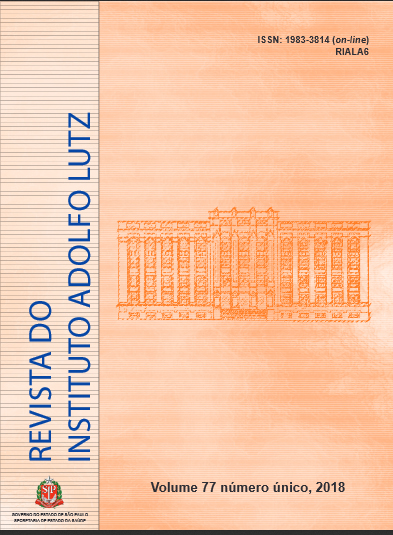Abstract
In a molecular biology laboratory there are standards to prevent nucleases from destroying the nucleic acids under analysis. Strict adherence to these standards is paramount, mainly in clinical analysis laboratories and when dealing with samples with a limited number of copies of the target genome. In contrast, several nucleases have been of fundamental importance, for example, in the identification of the type of viral nucleic acid, investigation of messenger RNA, virus purification in metagenomic approach, genome editing with the CRISPR/Cas system, and enzyme discovery. Knowledge of how nucleases can be both villains and allies is essential in the training of all working in the field of molecular biology.
References
1. Mishra NC. Nucleases: Molecular biology and applications. Hoboken (NJ): Wiley-Interscience;2002.
2. Farrell Jr. RE. RNA methodologies. A laboratory guide for isolation and characterization. 4.ed. Boston (MA): Academic Press;2010.
3. Miller JM, Astles R, Baszler T, Chapin K, Carey R, Garcia L et al. Guidelines for safe work practices in human and animal medical diagnostic laboratories. Recommendations of a CDC-convened, Biosafety Blue Ribbon Panel. MMWR Suppl. 2012;61(1):1-102. Disponível em: https://www.cdc.gov/mmwr/pdf/other/su6101.pdf
4. Sambrook J, Russell DW, editors. Molecular cloning: a laboratory manual. 3.ed. Cold Spring Harbor (NY): Cold Spring Harbor Laboratory Press;2001.
5. Whelan S. Viral replication strategies. In: Knipe DM, Howley, PM, editors. Fields virology. 6.ed. Philadelphia (PA): Lippincott Williams and Wilkins; 2013. pp. 105-26.
6. Pereira HG, Flewett TH, Candeias JAN, Barth OM. A virus with a bisegmented double-stranded RNA genome in rat (Oryzomys nigripes) intestines. J Gen Virol. 1988; 69(Pt 11):2749-54. http://dx.doi.org/10.1099/0022-1317-69-11-2749
7. Rittié L, Perbal B. Enzymes used in molecular biology: a useful guide. J Cell Commun Signal. 2008;2(1-2):25-45. http://dx.doi.org/10.1007/s12079-008-0026-2
8. Ludert JE, Hidalgo M, Gil F, Liprandi F. Identification in porcine faeces of a novel virus with a bisegmented double stranded RNA genome. Arch Virol. 1991;117(1-2):97-107.
9. Ehresmann C, Baudin F, Mougel M, Romby P, Ebel J-P, Ehresmann B. Probing the structure of RNAs in solution. Nucleic Acids Res. 1987;15(22):9109-28. Disponível em: https://www.ncbi.nlm.nih.gov/pmc/articles/PMC306456/
10. Tomaru Y, Takao Y, Suzuki H, Nagumo T, Koike K, Nagasaki K. Isolation and characterization of a single-stranded DNA virus infecting Chaetoceros lorenzianus Grunow. Appl Environ Microbiol. 2011;77(15):5285-93. http://dx.doi.org/10.1128/AEM.00202-11
11. Alexander M, Heppel LA, Hurwitz J. The purification and properties of micrococcal nuclease. J Biol Chem. 1961;236(11):3014-9. Disponível em: http://www.jbc.org/content/236/11/3014.long
12. Baltimore D. RNA-dependent DNA polymerase in virions of RNA tumour viruses. Nature. 1970;226(5252):1209-11.
13. Temin HM, Mizutani S. RNA-dependent DNA polymerase in virions of Rous sarcoma virus. Nature. 1970;226(5252):1211-3.
14. Knipe DM, Howley PM, editors. Fields virology. 6.ed. Philadelphia (PA): Lippincott Williams and Wilkins;2013.
15. Weinberger B, Plentz A, Weinberger KM, Hahn J, Holler E, Jilg W. Quantitation of Epstein-Barr virus mRNA using reverse transcription and real-time PCR. J Med Virol. 2004;74(4):612-8. https://doi.org/10.1002/jmv.20220
16. Iwata S, Wada K, Tobita S, Gotoh K, Ito Y, Demachi-Okamura A et al. Quantitative analysis of Epstein-Barr virus (EBV)-related gene expression in patients with chronic active EBV infection. J Gen Virol. 2010;91(Pt 1): 42-50. http://dx.doi.org/10.1099/vir.0.013482-0
17. Bressollette-Bodin C, Nguyen TV, Illiaquer M, Besse B, Peltier C, Chevallier P et al. Quantification of two viral transcripts by real time PCR to investigate human herpesvirus type 6 active infection. J Clin Virol. 2014; 59(2):94-9. http://dx.doi.org/10.1016/j.jcv.2013.11.014
18. Greijer AE, Ramayanti O, Verkuijlen SA, Novalić Z, Juwana H, Middeldorp JM. Quantitative multi-target RNA profiling in Epstein-Barr virus infected tumor cells. J Virol Methods. 2017;241:24-33. http://dx.doi.org/10.1016/j.jviromet.2016.12.007
19. Garlapati S, Wang CC. Identification of an essential pseudoknot in the putative downstream internal ribosome entry site in giardiavirus transcript. RNA. 2002;8(5):601-11. Disponível em: https://www.ncbi.nlm.nih.gov/pmc/articles/PMC1370281/
20. Garlapati S, Wang CC. Structural elements in the 5’-untranslated region of giardiavirus transcript essential for internal ribosome entry site-mediated translation initiation. Eukaryot Cell. 2005;4(4):742-54. http://dx.doi.org/10.1128/EC.4.4.742-754.2005
21. Ambrose HE, Clewley JP. Virus discovery by sequence-independent genome amplification. Rev Med Virol. 2006;16(6):365-83. http://dx.doi.org/10.1002/rmv.515
22. Delwart EL. Viral Metagenomics. Rev Med Virol. 2007;17(2):115-31. http://dx.doi.org/10.1002/rmv.532
23. Allander T, Emerson SU, Engle RE, Purcell RH, Bukh J. A virus discovery method incorporating DNase treatment and its application to the identification of two bovine parvovirus species. Proc Natl Acad Sci USA. 2001;98(20):11609-14. http://dx.doi.org/10.1073/pnas.211424698
24. Djikeng A, Kuzmickas R, Anderson NG, Spiro DJ. Metagenomic analysis of RNA viruses in a fresh water lake. PLoS One. 2009;4(9):e7264. http://dx.doi.org/0.1371/journal.pone.0007264
25. Conklin BR. Sculpting genomes with a hammer and chisel. Nat Methods. 2013;10(9):839-40. http://dx.doi.org/10.1038/nmeth.2608
26. Gaj T, Gersbach CA, Barbas CF III. ZFN, TALEN, and CRISPR/Cas-based methods for genome engineering. Trends Biotechnol. 2013;31(7):397-405. http://dx.doi.org/ 10.1016/j.tibtech.2013.04.004
27. Soppe JA, Lebbink RJ. Antiviral goes viral: harnessing CRISPR/Cas9 to combat viruses in humans. Trends Microbiol. 2017;25(10):833-50. http://dx.doi.org/10.1016/j.tim.2017.04.005
28. Saey TH. Gene drivers spread their wings. Science News. 2015;188(12):16. Disponível em: https://www.sciencenews.org/article/gene-drives-spread-their-wings
29. Chen S, Yu X, Guo D. CRISPR-Cas targeting of host genes as an antiviral strategy. Viruses. 2018;10(1):e40. http://dx.doi.org/10.3390/v10010040

This work is licensed under a Creative Commons Attribution 4.0 International License.
Copyright (c) 2018 Silvana Beres Castrignano
